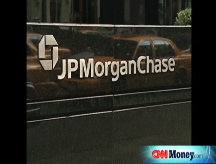Done deal: Bear belongs to JPMorgan
Shareholders approve buyout by JPMorgan Chase, marking the end of an era on Wall Street. But what does Jamie Dimon have planned next?
 |
| Now that JPMorgan Chase has scooped up Bear Stearns, investors wonder what JPMorgan Chase CEO Jamie Dimon plans to do next. |
NEW YORK (CNNMoney.com) -- JPMorgan Chase completed its historic bid for Bear Stearns Thursday, effectively closing one of the more dismal chapters in the annals of Wall Street.
Now, the Street's attention turns to what JPMorgan Chase CEO Jamie Dimon will do for an encore.
Nearly two-and-a-half months after the extraordinary tie-up was revealed, 84% of Bear Stearns (BSC, Fortune 500) shareholders endorsed the proposed takeover at a special meeting.
The approval of the deal marks the start of a new phase for JPMorgan ripe with both possibility and risk. With the acquisition, JPMorgan broadens its investment banking footprint but also inherits a big tab to clean up Bear's problems.
The purchase, unveiled on a Sunday evening in mid-March, heralded the end of the 85-year-old Bear Stearns and also demonstrated how vulnerable Wall Street had become as a result of the subprime mortgage meltdown.
Encouraged by federal regulators, including the Treasury Department and the Federal Reserve, JPMorgan (JPM, Fortune 500) originally agreed to buy Bear Stearns for $236 million, or just $2 a share, more than 90% below its closing price before the takeover was announced.
The move was made to help stave off a run on other investment banks and damage to the broader economy. But the Fed's actions later drew criticism from lawmakers due to the central bank's willingness to bail out Wall Street at a time when thousands of Americans were losing their homes.
Cracks first appeared in Bear Stearns' hull last July following the implosion of two of the companies' hedge funds, which were heavily invested in mortgage-backed securities.
In the following months, the company reported billions of dollars in writedowns, as did many of its Wall Street peers. CEO James Cayne stepped down in January, leaving Alan Schwartz at the company helm during its final days.
Bear Stearns' troubles came to a head the week of March 10, as rumors began to swirl about the health of the nation's fifth-largest investment bank. Days later on March 16, the deal was announced.
Investors cried foul at the initial $2 a share offering. A week later, JPMorgan raised its bid to roughly $10 a share, or approximately $2.2 billion at the time.
In the weeks that followed, Bear Stearns began the slow and painful process of letting go thousands of Bear Stearns workers. Last week, Dimon confirmed that JPMorgan would retain only 45% of Bear Stearns' 14,000 employees. But JPMorgan now faces what could be a long and tedious integration.
Some JPMorgan workers may also find themselves out of a job, warns Frank Barkocy, director of research at Mendon Capital Advisors Corp.
"That is still not fully resolved," he said. "I think they are looking to get quality personnel out of the combined entity and there will be some headcount reduction from the JPMorgan side."
At the same time, the deal exposes JPMorgan to lawsuits tied to Bear Stearns' subprime mortgage division as well as risks from Bear's derivatives business.
Earlier this month, JPMorgan said it would take $9 billion to clean up Bear Stearns' balance sheet. But that number could grow given Bear's vast mortgage portfolio and the continued deterioration in the housing market.
"Honestly, it's hard to tell," said Adam Compton, senior research analyst at RCM Capital Management, a San Francisco-based investment manager. "Frankly nobody from the outside has any idea what Bear's balance sheet looks like."
Despite the headaches, many bank experts think the purchase will turn out to be a savvy move. The New York-based bank will acquire Bear Stearns' prime brokerage business, a profitable division that services hedge fund clients.
Dimon, speaking at JPMorgan's annual shareholder meeting last week, said the deal is expected to generate roughly $1 billion in after-tax earnings for JPMorgan by 2009.
While JPMorgan's focus in the coming months will be on bringing Bear fully into the fold, other bank analysts say Dimon may not be done shopping yet.
Ryan Lentell, an analyst with Morningstar, said JPMorgan is in a strong enough financial position that they could probably pull off another deal even while still working on the Bear Stearns integration.
Dimon has said publicly on a number of occasions that he would be open to acquiring a regional bank if the price was right and the deal made sense.
It has long been rumored that JPMorgan is looking to acquire a regional bank with a presence in either the South or on the West Coast.
Last month, JPMorgan was reportedly close to a deal with Washington Mutual (WM, Fortune 500) last month, before the Seattle-based thrift spurned its bid, instead selling a $7 billion stake to an investment group led by the private-equity firm TPG. ![]()


